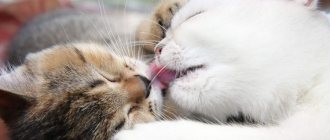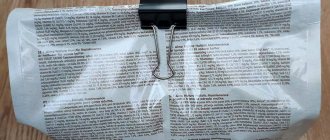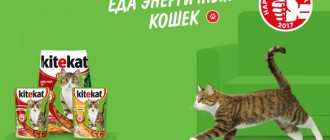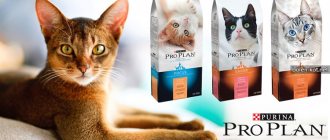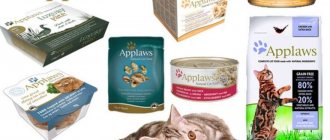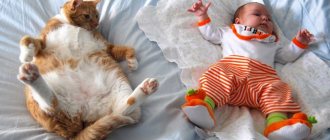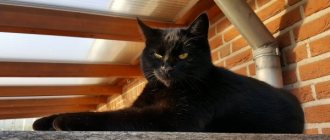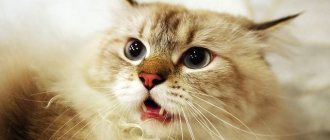The owner of a cat is always looking for healthy and tasty food for his friends, rich in beneficial properties and high-quality ingredients that will make the pet’s nutrition unforgettable. However, often a cat can behave strangely and unmotivated in our eyes.
We find ourselves in a situation where a feline may refuse food that they have always been accustomed to and liked, and we ask ourselves why. Let's look today at why a cat doesn't want wet food and how to find a solution.
Temperature
In the wild, cats eat their prey while it is warm. Indoor cats don't like cold wet food either. Also, the consistency and flavor changes after being refrigerated.
A cat may well agree to eat food from a freshly opened pack, but refuse food from the refrigerator.
Before cooling, the gravy of the canned food or pouch is a nice, tasty liquid that coats all the pieces. The cat has a desire to eat the entire portion.
When you take wet food out of the refrigerator, the gravy becomes thick and congealed. In addition, the pleasant aroma disappears. This type of food is not attractive to the cat.
Tip 1: Heat the food until the liquid consistency and stronger aroma returns
Tip 2: Store the remaining food in an open package not in the refrigerator, but in a bowl of cold water. To keep the water useful longer, add a couple of pieces of ice to the bowl. This will keep the food fresh throughout the day without losing its texture or flavor.
Why does my cat no longer eat the food he used to eat?
Contents hide
Sometimes it happens that a pet does not want to eat its usual food, which just yesterday it was gobbling up both cheeks. Despite obvious hunger, the cat refuses to even approach the bowl. Do not rush to scold your pet and accuse him of being spoiled. The reasons for this behavior may be deeper.
The food has run out . Most often this happens with dry food. The attractive aroma of food is important to cats. Cats have trouble seeing in front of them, so they find food by smell. If the bowl does not smell of anything, it means it is empty and you should ask the person for food.
To prevent this from happening, keep bags and cans of food tightly closed. Also remember to check the expiration date. Expired food not only loses or changes its smell, but also becomes unsafe for your pet's health.
The owner forgets to wash the plate . Sometimes it happens the other way around: the bowl smells so bad that the cat simply doesn’t want to go near it. It is unlikely that the owners themselves would want to eat from dirty plates with flies circling over them.
Place food in a clean bowl, do not be lazy to throw out dried remains, wash and wipe the container dry. Compliance with the rules of hygiene promotes excellent appetite and prevents diseases, in particular intestinal disorders. Also, do not forget to wash the place where the bowl is – the tray or the floor.
Bad batch . The manufacturer may have a defect, for example, the food was prepared from low-quality raw materials. The recipe may also change. Cats are sensitive to smells and will immediately understand that food is spoiled or smells different, unusual. Cats are conservative, so they may not like the new consistency - too liquid or, conversely, too coarse and viscous.
Try buying food elsewhere or the same brand but with a different flavor. Don't forget about the expiration date. It is also not recommended to take loose dry food. Sellers pour it out of large bags in which the granules are stored for who knows how long. Perhaps the food simply dried out or, on the contrary, became damp and tasteless. Buy the same food, but in a sealed commercial package. The cat will probably like it more.
The cat is sick . Observe how your pet behaves at the bowl. If it fits, starts eating and immediately leaves, it is recommended to check the gums and teeth. Perhaps it hurts the cat to chew and that’s why he stops. If the teeth are in order, you should pay attention to the toilet: the cat may have indigestion.
The worst thing is if the cat ignores food altogether and sleeps a lot. Most often, this behavior indicates illness - from headaches to tumors. In this case, be sure to show the cat to the veterinarian.
The cat was spoiled . Yes, this can happen too. If, in addition to food, you like to feed from the table, give a lot of treats and delicacies, get ready for the periodic whims of your pet. The cat knows that in addition to the usual “banal” food there is a lot of other tasty things, and he will not refuse a tasty addition.
Try not to overfeed your pet with delicacies. Wean you off the table and eating from your hands immediately (or better not at all). The cat should eat food that is suitable for its age, health and weight. An unbalanced diet and “bite eating” lead to indigestion, allergies, weight gain and behavioral problems.
Photo source:
Tired of food
Cats, like people, can become bored with the same food over a long period of time. If your cat has been eating wet food for more than a year, it is likely that she may have become bored with it.
Tip 1: Do not give your cat the usual wet food for a couple of days or more. Perhaps after a break she will be happy to accept it.
Tip 2: Place a treat inside the wet food. The cat will eat the treat first and then move on to the main portion of food.
You can also enhance the taste with treats in the form of broths and gravies.
Tip 3: try choosing food from the same line, but with a different taste. Flavors typically offered include chicken, turkey, lamb, tuna, and beef.
Also experiment with the texture of the food: pates, pieces, shredded meat, etc.
You may need to consider other brands of food.
Tip 4: if your cat only receives wet food, then try adding dry food from the same line to the diet. This way you diversify the menu. Study the manufacturer's recommendations for the proportions and ratio of wet and dry diets.
If your pet is on a nutritional diet, be sure to consult with your veterinarian before making dietary changes.
You might be wondering: How to get a cat to eat medicated food?
Rules for switching to new food
When changing your usual diet, you need to be patient and consistent. You should not scold an animal or indulge it when it presses for pity. A sharp transition is harmful to health, so the new food needs to be mixed a little with the old one. On average, this takes 1-2 weeks.
Frequent product changes are harmful!
Frequently changing brands is fraught with problems with the gastrointestinal tract. To avoid diarrhea and constipation, veterinarians recommend sticking to a specific brand even on a therapeutic diet. This is not so difficult, since most manufacturers produce several lines that take into account the age and other characteristics of the animal.
Transition from straight
It's not safe to mix different types of foods, so don't be surprised by temporary bowel problems. In this case, this cannot be avoided, so be patient and adhere to the following scheme:
- 25% “drying” and 75% natural – 1-4 days;
- 50% of each type – 5-9 days;
- 75% “drying” and 25% natural – 9-14 days.
At the end of 2 weeks, pellets should make up 100% of the diet. For the first 4 days, you can soak them a little in water so that your pet is not scared off by the unusual consistency.
Switching from wet food
Feeding only wet canned food softens the gums, causing increased bleeding and premature tooth loss. For this reason, they should be combined with dry granules.
The principle of transition here is similar to the previous point. The only difference is that the final proportion must correspond to the instructions on the food packaging. There are detailed rules for feeding animals with 2 types of food.
Please note that increasing the amount of dry kibble will require a large amount of liquid to digest it. Make sure your pet drinks enough water and replace it with fresh water regularly.
The composition has changed
Sometimes the same wet food can vary in consistency and taste from batch to batch. Perhaps the manufacturer has changed the composition and formula of the product. Compare the ingredients on the old and new packaging. You can also contact the manufacturer and clarify the information. Even if you find out that the formula has not been changed, you cannot be absolutely sure.
If all your cats refuse to eat this food, then it is likely that the problem is due to the changed composition.
Perhaps the food has simply spoiled due to improper storage in a warehouse, store or at your home.
Why does a cat eat poorly?
To understand the reasons for decreased appetite in cats, we spoke with breeders and veterinarians.
Here are the reasons leading to refusal of food, which were identified by experts:
Read also: How to stop a child from sucking hair?
Reason 1
Switching to a new food
Cats usually refuse to eat after a change in diet. Especially if they switch from raw meat or economy-class food to premium, super-premium or holistic food.
Bowl not clean enough
There are often wet food residues left in the bowl. If washed irregularly, an unwanted odor appears. Cats are not only picky eaters, but also hypersensitive to smells.
If the food has been sitting out for too long or the bowl is dirty, it is likely that the cat will refuse to eat.
Try to wash the bowl regularly and thoroughly, without using strong-smelling detergents.
Opt for metal or ceramic bowls as they are easier to clean. Cheap plastic accumulates bacteria and odor.
The cat stopped eating dry food because he got sick
Most serious illnesses are accompanied by a decrease or complete loss of appetite. Therefore, if your pet refuses dry food, take a closer look to see if he has other alarming symptoms.
Signs:
- general malaise: the cat ceases to be interested in games, tries to hide in a secluded place;
- digestive problems: diarrhea, constipation, vomiting, retching;
- increased body temperature;
- pathological discharge from the eyes and nose;
- excessive shedding, itching, rash on the skin and mucous membranes;
- The cat stopped eating not only dry food, but also any other food.
Whiskers sensitivity
A cat's whiskers are sensory receptors connected to their nervous system. Any movements or touches send signals to the brain.
Some cats don't like their whiskers getting dirty and clinging to the bowl.
When the whiskers touch the food and bowl too often, it results in an overload of sensory messages. The cat may become nervous and lose its appetite. This phenomenon is called “whisker fatigue.”
Here are the symptoms that your cat is experiencing “whisker fatigue”:
- walks around the bowl and meows
- refuses to eat from his own bowl
- trying to get food out of the bowl
- becomes aggressive with food when he takes it out of the bowl
Solution: a wide but shallow bowl that is comfortable for the cat.
The cat refuses to eat
An alarming situation arises when a cat suddenly stops eating familiar food and does not even respond to treats. This may happen for the following reasons:
- Diseases - from toothache and intestinal infections to pancreatitis and kidney failure.
- Medical procedures - loss of appetite is considered one of the side effects of vaccination, and after operations using anesthesia, the cat may not eat for up to two days.
- Changing the situation - rearranging furniture, repairs, moving, traveling. In the last two cases, the cat may also feel sick from motion sickness in a car or plane.
- Psychological problems - stress, lack of attention, conflicts with family members and other pets.
What to do. Consult your veterinarian as soon as you notice changes in your cat's eating habits. The faster you respond to a problem, the greater the chances of a favorable resolution.
Cats are demanding about cleanliness, be careful
If a cat stops eating dry food because of dirty dishes, the owner just needs to start paying more attention to his responsibilities.
There is constant talk about the need to maintain a drinking regime when your pet eats exclusively dry food. It is important to keep the bowl clean , wash it regularly, and constantly change the water in the drinking bowl. Feed manufacturers warn about the consequences of violating the drinking regime by making appropriate notes on the packaging.
© shutterstock
